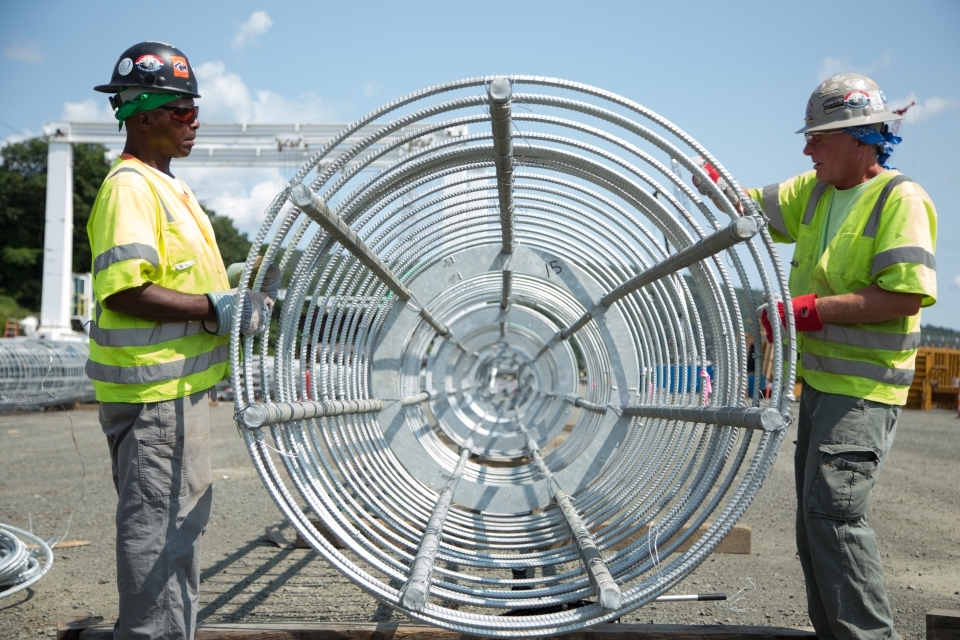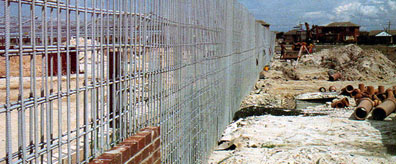Engineering & Mechanical Properties

(Photo Credit: New York State Thruway Authority)
Engineering & Mechanical Properties
When galvanized reinforcing steel is specified, the design requirements and installation procedures employed should be no less stringent than for structures where uncoated or bare steel reinforcement is used. The CGR coating provides the exact same experience for using rebar as conventional bare rebar. However, for HDG rebar, there are some special requirements that need to be observed.
The following information is intended as a guide for designers, engineers, contractors, and inspectors. They are intended as a supplement to other codes and standards dealing with the design, fabrication, and installation of reinforced concrete structures, and deal only with those special considerations that arise due to the use of galvanized steel.
Bending Galvanized rebar
CGR rebar can be formed after galvanizing in the same way as bare uncoated rebar. The pure zinc coating is more formable than the base steel, so the zinc coating does not restrict formability of the rebar. CGR can be processed on automated rebar bending machines.
When fabrication of HDG rebar is performed after galvanizing, some cracking and flaking of the galvanized coating will occur in the bend areas. The thicker intermetallic layers of HDG rebar are brittle and can crack and flake during forming after galvanizing.
Bending Rebar prior to Galvanizing
The continuous galvanizing process can not be used to coat pre-bent rebar. The continuous inline process coats straight bars only. These can easily be formed after galvanizing.
When bending rebar prior to HDG galvanizing, it is recommended that the bend radii be as large as possible in order to avoid strain age embrittlement during galvanizing, the accelerated aging of the steel by cold working. In the specification, ASTM A 767, there is a table that gives guidelines for the recommended bend diameter for HDG rebar based on the bar size:
|
Bar No. |
Grade 300 [40] |
Grade 350 [50] |
Grade 420 [60] |
Grade 520 [75] |
|
10, 13, 16 [3, 4, 5] |
6dA |
6d |
6d |
… |
|
19 [6] |
6d |
6d |
6d |
6d |
|
22, 25 [7, 8] |
6d |
8d |
8d |
8d |
|
29, 32 [9, 10] |
… |
… |
8d |
8d |
|
36 [11] |
… |
… |
8d |
8d |
|
43, 57 [14, 18] |
… |
… |
10d |
10d |
|
Ad = nominal diameter of bar |
||||
Bond Strength
Arguably the most important property contributing to a successful reinforced concrete structure is the bond strength between the reinforcing steel and the concrete. A strong bond must be developed in order for the concrete to achieve its designed capacity. Factors that influence the strength or reinforced concrete include, but not limited to, are bar diameter, the absence or presence of bar surface deformations (ribs), the geometry of the ribs, concrete cover over the bars, and the orientation in the concrete matrix.
The following graph compares the bond strength of galvanized rebar and black steel.
Good bonding between reinforcing steel and concrete is essential for reliable performance of reinforced concrete structures. When protective coatings on steel are used, it is essential to ensure that these coatings do not reduce bond strength. Studies on the bonding of galvanized and black steel bars to Portland Cement concrete have been investigated. The results of these studies indicate:
- Development of the bond between steel and concrete depends on age and environment
- In some cases, the time required for developing full bond strength between steel and concrete
may be greater for galvanized bars than for black, depending on the zincate/cement reaction - The fully developed bond strength of galvanized and black deformed bars is the same.
Mechanical Properties
Ductility and Yield/Tensile Strength
Ductility and strength of reinforcing steel are important to prevent brittle failure of reinforced concrete. Studies on the effect of galvanizing on the mechanical properties of steel reinforcing bars have demonstrated that the tensile, yield, and ultimate strength, ultimate elongation, and bend requirements of steel reinforcement are substantially unaffected by hot-dip galvanizing, provided proper attention is given  to steel selection, fabrication practices and galvanizing procedures. The effect of the galvanizing process on the ductility of steel bar anchors and inserts after being subjected to different fabrication procedures has also been investigated. The results demonstrate conclusively that, with correct choice of steel and galvanizing procedures, there is no reduction in the steel’s ductility.
to steel selection, fabrication practices and galvanizing procedures. The effect of the galvanizing process on the ductility of steel bar anchors and inserts after being subjected to different fabrication procedures has also been investigated. The results demonstrate conclusively that, with correct choice of steel and galvanizing procedures, there is no reduction in the steel’s ductility.
Fatigue Strength
An extensive experimental program examining the fatigue resistance of galvanized steel reinforcement shows that deformed reinforcing steel, exposed to an aggressive environment prior to testing under cyclic tension loading, performs better when galvanized.
Dissimilar Metal Contact
Another consideration when using galvanized reinforcement in concrete is the possibility of establishing a bimetallic couple between zinc and bare steel (i.e., at a break in the zinc coating or direct contact between galvanized steel and black steel bars) or other dissimilar metals. A bimetallic couple of this type in concrete should not be expected to exhibit corrosive reactions as long as the two metals remain passivated. To ensure this is the case, the concrete depth to the zinc/steel contact should not be less than the cover required to protect black steel alone under the same conditions.
Therefore, when galvanized reinforcement is used in concrete, it should not be coupled directly to large areas of black steel reinforcement, copper, or other dissimilar metal. Bar supports and accessories should be galvanized. Tie wire should be annealed wire, 16-gauge or heavier, preferably galvanized. If desired, polyethylene and other similar tapes can be used to provide insulation between dissimilar metals.

